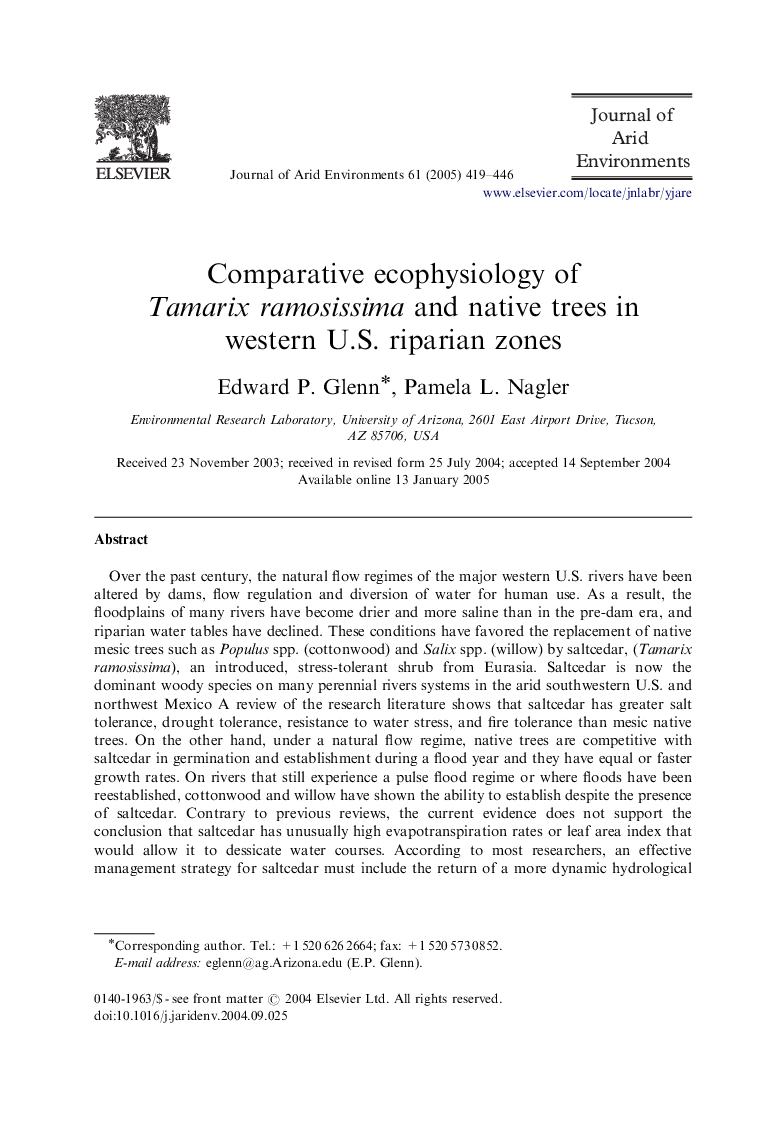| کد مقاله | کد نشریه | سال انتشار | مقاله انگلیسی | نسخه تمام متن |
|---|---|---|---|---|
| 9447929 | 1305576 | 2005 | 28 صفحه PDF | دانلود رایگان |
عنوان انگلیسی مقاله ISI
Comparative ecophysiology of Tamarix ramosissima and native trees in western U.S. riparian zones
دانلود مقاله + سفارش ترجمه
دانلود مقاله ISI انگلیسی
رایگان برای ایرانیان
کلمات کلیدی
موضوعات مرتبط
مهندسی و علوم پایه
علوم زمین و سیارات
فرآیندهای سطح زمین
پیش نمایش صفحه اول مقاله

چکیده انگلیسی
Over the past century, the natural flow regimes of the major western U.S. rivers have been altered by dams, flow regulation and diversion of water for human use. As a result, the floodplains of many rivers have become drier and more saline than in the pre-dam era, and riparian water tables have declined. These conditions have favored the replacement of native mesic trees such as Populus spp. (cottonwood) and Salix spp. (willow) by saltcedar, (Tamarix ramosissima), an introduced, stress-tolerant shrub from Eurasia. Saltcedar is now the dominant woody species on many perennial rivers systems in the arid southwestern U.S. and northwest Mexico A review of the research literature shows that saltcedar has greater salt tolerance, drought tolerance, resistance to water stress, and fire tolerance than mesic native trees. On the other hand, under a natural flow regime, native trees are competitive with saltcedar in germination and establishment during a flood year and they have equal or faster growth rates. On rivers that still experience a pulse flood regime or where floods have been reestablished, cottonwood and willow have shown the ability to establish despite the presence of saltcedar. Contrary to previous reviews, the current evidence does not support the conclusion that saltcedar has unusually high evapotranspiration rates or leaf area index that would allow it to dessicate water courses. According to most researchers, an effective management strategy for saltcedar must include the return of a more dynamic hydrological regime to regulated rivers, allowing saltcedar and native trees to coexist to maximize the habitat value of the riparian zone.
ناشر
Database: Elsevier - ScienceDirect (ساینس دایرکت)
Journal: Journal of Arid Environments - Volume 61, Issue 3, May 2005, Pages 419-446
Journal: Journal of Arid Environments - Volume 61, Issue 3, May 2005, Pages 419-446
نویسندگان
Edward P. Glenn, Pamela L. Nagler,